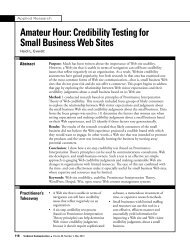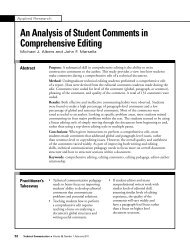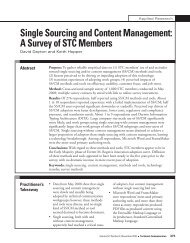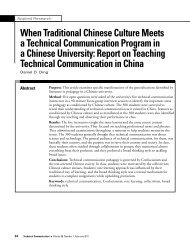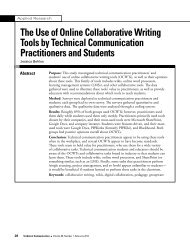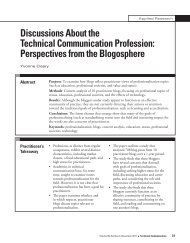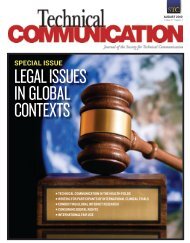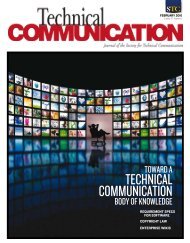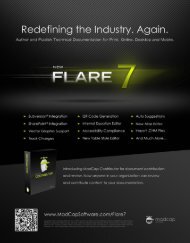Applied ResearchThe First Wave (1953–1961) of the Professionalization MovementFigure 9: EnglishProfessor HenriettaJ. Tichy (1912–1994?), the firstwoman fellow ofSTC (“Two Fellows,”1968). The authorof Effective Writingfor Engineers,Managers, andScientists (1966),Tichy taughttechnical writingand literatureat Hunter College in New York City. Photo from the STCarchives.TWE, STW, and TPS apparently had some successin “establishing” bona fide degree programs at collegesand universities. In the mid-1950s, STW worked closelywith administrators at Simmons College, a woman’scollege in Boston, to create a four-year undergraduatedegree program in technical writing. Students pursuingthis degree, in effect, had to double-major in journalismand one of the following technical/scientific areas:electronics, chemistry, or biology (“Program,” 1956).STW described its involvement as follows:… plans were not finalized until this past winter[1955–1956] after discussion between members ofthe School of Publications and practicing technicalwriters, members of the STW Boston ChapterEducation Committee. Stimulated by the interestshown by these STW members and by their promiseof cooperation, college officials approved immediateaction on the new program. (“Program,” 1956, p. 69)Launched in fall 1956, the curriculum for the degreeconsisted of such courses as graphic arts, editing andpublishing techniques, layout and design, and articlewriting, but no courses with the title “technical writing”or “technical editing” (“Program,” 1956). The title ofthe degree was “Technical Writing and Publishing,”however, rather than “Technical Journalism” (SimmonsCollege, 1957, p. 41). Other colleges and universities(e.g., Iowa State, Kansas State) were offering bachelor’sdegrees in technical journalism at an earlier date(Cortelyou, 1958), but the Simmons program may bethe first, nominally, in technical writing.In 1958, Erwin Steinberg, an English professor,started an undergraduate degree program in technicalwriting and editing at Margaret Morrison CarnegieCollege, the women’s college at Carnegie Institute ofTechnology (Carnegie Tech, now Carnegie MellonUniversity) in Pittsburgh (Figure 10). Steinberghad a working relationship with the TWE/STWEPittsburgh chapter, and especially its vice-chairman H.C. McDaniel. Each year at Carnegie Tech, Steinbergand McDaniel “put together a full day of lectures andworkshops on various aspects of technical writing oneday a year” (Erwin Steinberg, personal communication,June 28, 2007). It is likely that Steinberg consultedMcDaniel or the chapter about the curriculum for theCarnegie Tech degree. As the editor of the WestinghouseEngineer and the manager of a large group of technicalcommunicators at Westinghouse, McDaniel was thecenter of technical writing activity in Pittsburgh duringthis period (Janis Ramey, personal communication,September 9, 2009).Figure 10: English Professor Erwin R. Steinberg (b. 1921)with the first students in the technical writing and editingprogram at Margaret Morrison Carnegie College. Left toright: Ellen Brady, Sara Shook, Sally Gannon, Steinberg,Janis Geisler (aka STC Fellow Janis Ramey), and NancyFerree. Reprinted from the Pittsburgh Press, October 1958.By 1960, only a few universities were offering degreeprograms in technical communication, but STWP’sEducation and Professional Development Committee(EPPC) was already discussing STWP-sponsoredaccreditation of such programs. The following passagecomes from the minutes of the Nov. 4, 1960, STWPBoard of Directors Meeting:298 Technical Communication l Volume 58, Number 4, November 2011
Applied ResearchEdward A. MaloneA discussion was held concerning whether theEPPC should establish, on behalf of the society,realistic curricula standards for university degreesin technical writing, technical illustration, andother fields it may deem proper, and to recommendto the Board appropriate ways of determiningwhether these standards are being met by particulareducational institutes so that the society can grant orwithhold approval of curricula on this basis. (Berry,1960, p. 6)This initiative was obviously premature and did notbear fruit. At this early date, the profession lacked awell-developed, specialized body of knowledge and corecompetencies. As Rainey, Turner, & Dayton (2005)argued many decades later, “Only with a process ofcodification and certification will the profession bein a position to establish accreditation of academicprograms” (p. 335).The challenge of creating effective academicprograms was bigger than the first generation ofprofessionals had anticipated. For this reason, theydid not succeed on the scale they had hoped. Thecooperation between academics such as Flint andSteinberg on the one hand and practitioners such asHickok (a former high school teacher) and McDaniel onthe other was undercut by the general ill will betweentheir camps. As Gould (1989) recalled, “In the earlydays, the 50s, technical writing and the technical writerswere without much honor, especially in academiccircles” (p. 169). The reverse was also true. Duringthe merger negotiations between TWE and STW, aTWE member asked, “How can they [STW] have aman like Flint in their organization? He is an Englishprofessor” (TWE, 1956, p. 98). These attitudes poseda formidable obstacle to collaborative educationalinitiatives. A decade after the formation of TWE,Hamlett (1963) lamented that “Education has notanswered the challenge for higher standards in preparinggraduates for technical writing careers” (p. 22). Anotherdecade later, Colby (1975) was complaining thatRennselaer Polytechnic Institute’s graduate degreeprogram in technical writing (which had been startedin 1953, the same year that TWE and STW werefounded) was the only academic program in technicalcommunication that he really trusted.We have continued to create academic programsin technical communication (more than 223 in 2011by one count [STC, 2011]), but we have not succeededin implementing uniform program assessment protocolsor an accreditation system. There is evidence thatindustry desires such quality assurance when hiringuniversity graduates in technical communication.Malcolm (1987) noted that a 1983 survey conductedby STC indicated that employers of technicalcommunicators were interested in having STC vetand accredit academic programs.Legal RecognitionAnother current issue in professionalization isgovernment recognition of the profession. On January25, 2010, STC issued a press release declaring that “STCEfforts Realized as U.S. Government AcknowledgesTechnical Writers as Distinct Profession.” The pressrelease was referring to the fact that the job title“Technical Writer” had been given its own chapter inthe 2010 edition of the government’s OccupationalOutlook Handbook. By separating technical writers fromother types of communicators, the U.S. governmentwas acknowledging that technical writing had differentrequirements than other types of writing. According tothe news release, this change was important because itgave technical communicators authoritative evidenceto use in discussions with employers about the status oftheir profession (O’Sullivan, 2010).Although the U.S. Bureau of Labor Statisticsdid not formally acknowledge technical writing as adistinct profession until 2010, governmental agencieshave long recognized technical writing as a distinctactivity and “technical writer” and “technical editor” asofficial job titles. The National Advisory Commissionfor Aeronautics (NACA), NASA’s predecessor, had“Assistant Technical Editor” as an official job title asearly as 1935 (NACA, 1941). That editor, Pearl I. Young(Figure 11), was a scientist by education who workedwith NACA engineers on their reports, and in later yearsshe taught in-house report writing courses, produceda style manual for NACA reports, and supervised anediting group of mainly women (Verniel & Douglas,1996). Thus, Young was one of the first—if not thefirst—U.S. government employees with the job title“Technical Editor” in the modern sense.Volume 58, Number 4, November 2011 l Technical Communication 299



